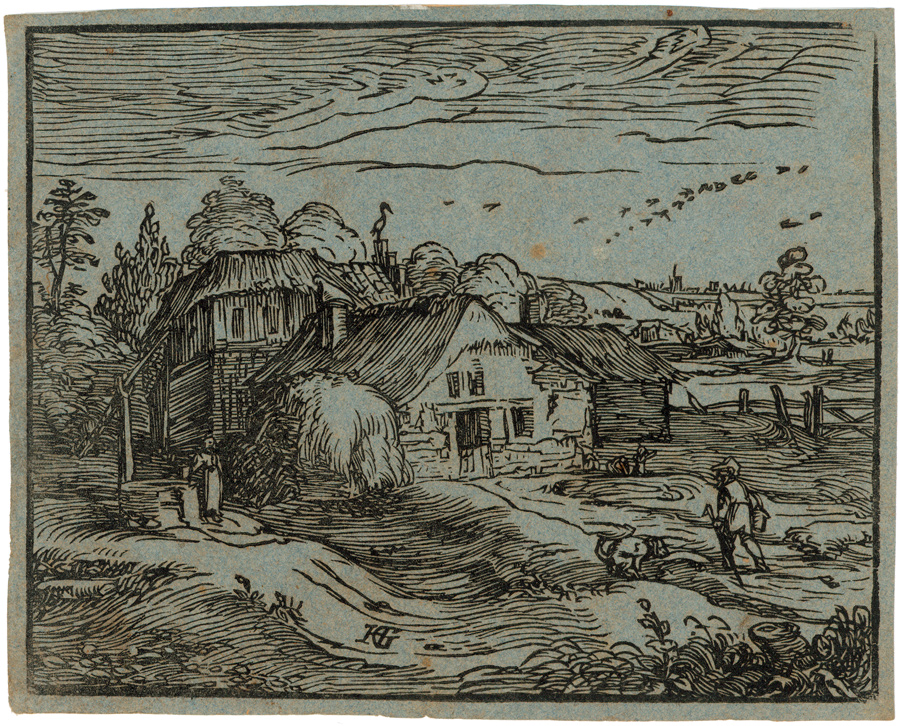Loading the page ...
Hendrick Goltzius
(1558 Mühlbracht – 1617 Haarlem)
Landscape with Trees and a Shepherd Couple; Landscape with a Farmhouse. 2 woodcuts on blue paper. 11.2 x 14.4 and 11.3 x 14.3 cm respectively. Ca. 1597–1600. Bartsch 243–244; Hirschmann 379–380 I (of II); Hollstein 379–380 I (of II); Bialler 50–51 I (of II). Unidentified watermark.
These astounding, densely atmospheric observations of nature belong to the series of the Four Small Landscapes that was probably done between 1597 and 1600. The prints are extraordinary in both technical and iconographic terms. The woodcut technique employed by Goltzius was a little-used medium in Holland at the time. Also unusual is the fact that these are pure landscapes without any underlying mythological or religious significance. In this respect they mark an important step in the development of Dutch landscape art.
The Landscape with Trees and a Shepherd Couple illustrates this new attitude in exemplary fashion. The intimate scene is filled with a nature lyricism reminiscent of such Venetian predecessors as Campagnola and Titian. The down-to-earth observation of nature is combined with intense focus in the composition. Different, brilliantly characterized motifs have been remarkably condensed in a small format, all harmoniously linked with one another and never creating an impression of artificiality or clutter. A peasant couple is resting under a clump of trees stirred by the wind, while a herdsman peacefully tends his flock in the background. In the valley on the right we can make out a collection of cottages and the spire of a tower, while on the horizon a range of mountains looms. Bushes, trees and clouds are full of pulsating life. It is an utterly profane idyll that Goltzius depicts, devoid of any reference to mythological beings or a god. The robust character of the woodcut technique proves to be an ideal medium for rendering a direct and unvarnished view of nature. The same observation applies to the Landscape with a Farmhouse, even if it does show a more pronounced tendency towards genre. Instead of the lyrical mood of the pastoral landscape, Goltzius’ observation of nature here is more true to life and in some respect more anecdotal. The farmhouse with the haystack, the well and the dune landscape in the background are all compositional elements that soon after will recur frequently in the work of Esaias and Jan van de Velde and other pioneers of Dutch landscape etching. Goltzius’ draughtmanship, however, is quite distinctive and highly individual. In the rendering of the terrain in the foreground wavy lines are skilfully alternated with blank spots, thus creating a sense of space. The bold confidence of line lends the scene a high degree of intensity.
The Landscape with Trees and a Shepherd Couple.
In the earliest impression of the first state in Stuttgart the line block shows almost no wear. Although in our impression the borderline has been printed somewhat unevenly in places as a result of underinking of the line block (especially at upper right), the features described by Bialler for later impressions do lack completely. The two gaps in the right margin, which are already clearly visible in the Amsterdam impression (Bialler, p. 183,
fig. 50 I b), are discernible on our proof only as two fine hairline cracks, while the small worm holes on the tree trunk and in the foliage are fully absent. As in the Stuttgart impression, the central clump of trees is printed more strongly and the landscape in the background seems lighter in tone, thus evoking a sense of depth. It may therefore be taken that our impression was printed as early as the Stuttgart impression.
The Landscape with a Farmhouse.
The same observations apply to this impression, which is slightly superior to the previous print in terms of clarity and brilliance. The impression is sharp and perfectly even and is in every respect the equal of the Stuttgart impression (Bialler, p. 185, fig. 51 I), if not superior. The small gap in the upper right corner of the borderline is not the result of a crack in the line block, but is also due to underinking. In our impression the borderline at the top left is stronger and more evenly printed than in the Stuttgart impression. A slight difference is also noticeable in the flock of birds in the sky. In the Stuttgart impression the sixth bird from the right reveals a tiny gap, while in ours the silhouette of the bird is complete. As in the Stuttgart impression, the line block is perfectly intact, while the little worm holes characteristic of subsequent impressions of the first state are completely absent.
The Small Landscapes were originally intended to be plain woodcuts, even if most of the impressions are printed on blue paper. After the line blocks showed the first signs of wear, two tone plates were added in the second state so that the woodcuts could be printed in the chiaroscuro technique. This took place during the artist’s lifetime and may also have been inspired by aesthetic considerations. The chiaroscuros exert a marked dramatic impact and convey a more vivid and powerful sense of space. This tendency matched the stylistic development in Goltzius’ landscape drawings, which after 1600 often were executed as watercolours.
In both impressions the blue paper tone has largely been freshly preserved. Minimal aging, insignificant traces of mounting on the verso, otherwise in excellent and unrestored condition and of museum quality.
